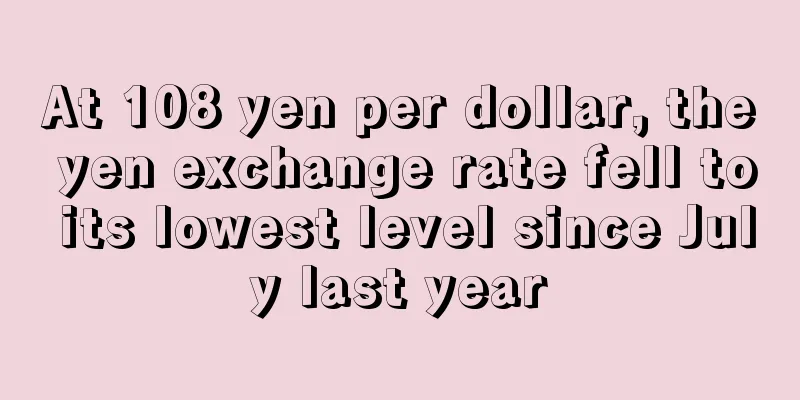At 108 yen per dollar, the yen exchange rate fell to its lowest level since July last year

|
On March 5, in the Tokyo foreign exchange market, affected by factors such as the rise in long-term interest rates in the United States, the US dollar was bought, the yen depreciated and the US dollar appreciated . The highest increase once reached 1 US dollar = 108 yen , which was the lowest level of the yen against the US dollar since July last year .
On March 4, the USD/JPY exchange rate in Tokyo's foreign exchange market opened at around 106.994 yen in early trading, up 0.13 yen from the previous trading day . One day later, the USD/JPY exchange rate in Tokyo's foreign exchange market opened at around 107.948 yen in early trading , up 0.86 yen from the previous trading day.
Against the backdrop of another rise in long-term interest rates in the United States, the USD/JPY exchange rate continued to break upward, once breaking through the 108 yen integer level before closing at a high level.
Previously, all economic data released by the United States were unsatisfactory, especially the ADP private sector job growth , which is a precursor indicator of official employment statistics , was far below market expectations. Coupled with the market's forecast that the Federal Reserve will extend its loose financial policy and the government's expectation that it will introduce larger-scale stimulus policies , long-term interest rates have been further increased.
A person related to the Japanese market said : "Federal Reserve Chairman Powell's speech on the 4th did not show a strong sense of vigilance against rising long-term interest rates in the United States."
However, since interest rates in the Tokyo market are high following those in overseas markets, it is likely that purchases of U.S. dollars are underway or have already occurred, given the decline in long-term interest rates in Japan and the interest rate differential between Japan and the United States.
As the market has been quite sensitive recently, large fluctuations in the USD/JPY exchange rate cannot be ruled out, and we should also be wary of the amplifying effect of stop-loss trading on market materials.
From a technical perspective, the USD/JPY exchange rate continued to rise from the upper limit of the range in late trading, showing a strong upward momentum in the short term. The US long-term interest rate still maintains a medium-term upward trend, which may further widen the US-Japan interest rate gap , so Japanese sellers also need to pay more attention. JPY exchange rate Japanese Market |
<<: eBay launches managed payment service in France, Italy and Spain
Recommend
The listed furniture e-commerce giant has no one to take over and is on the verge of bankruptcy!
In this year's cross-border e-commerce market...
What is CoGoLinks? CoGoLinks Review, Features
CoGoLinks is a cross-border payment brand under Ji...
What is HuanJin Technology & HuanJin Technology Review: Features, Pros & Cons, and Best Use Cases
Shenzhen Huanjin Technology Co., Ltd. (referred t...
What is Guangdong Tianyun Cross-border E-commerce Service Co., Ltd.? Guangdong Tianyun Cross-border E-commerce Service Co., Ltd. Review, Features
Tianyun Cross-border is a cross-border e-commerce...
Dunlop Tires launches e-commerce business in Brazil
Dunlop Tires has launched its e-commerce business...
What is Tongtu ERP & Tongtu ERP Review
"Tongtu" is a product of Aishang Online...
Poshmark performed poorly after its IPO and launched a video feature to attract sellers
According to foreign media Retail Dive , Poshmark...
Exchange rate fluctuations affect foreign trade companies. Alibaba International Station's "Exchange Lock" helps merchants stabilize profits
In 2020 , China's foreign trade rebounded aga...
What is Parsimony? Parsimony Review, Features
The power of Parsimony comes from building and pro...
What is ShopLocal? ShopLocal Review, Features
ShopLocal is a shopping price comparison website ...
What is Huayunchang International Logistics? Huayunchang International Logistics Review, Features
Huayunchang International Logistics (Shenzhen Huay...
What is Catch of the Day? Catch of the Day Review, Features
Catch of the Day is an Australian online shopping...
What is Buybuybaby? Buybuybaby Review, Features
Founded in 2003, Buybuybaby is an American chain ...
Amazon will hold "Prime Day 2.0"? Official response: Rumor!
This year's Amazon Prime Day will be held on ...
What is Aim? Aim Review, Features
Aim is a Belgian company focused on acquiring suc...









